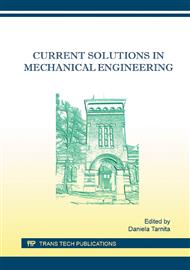p.467
p.473
p.479
p.485
p.489
p.495
p.501
p.507
p.513
The Crack Length Growth – A Fracture Parameter in a Stainless Steel Influenced by the Loading Test
Abstract:
The defects or micro-cracks that exist in a product mass from the elaboration phase, can extend controlled or not, because of a variable solicitation applied to a product or a sample. The Fracture Mechanics parameter that highlight the crack propagation in time is its rate growth marked as da/dN and represents the crack advancement length during a solicitation cycle. This can be studied based on some mathematical models obtained from some propose models, experimentally determined. In this paper, a propagation process analysis is made of a fracture crack by an axial-eccentric fatigue loading for a 10TiNiCr175 stainless steel. CT type flat samples were loaded with an asymmetry coefficient R= 0.3, for the solicitation temperatures: T= 293K (20°C), T= 253K (-20°C), respectively T= 213 K (-60°C). The crack growth increase was studied by three most used mathematical models: the polynomial method standardized according to ASTM E647, method proposed by Paris and method proposed by Walker.
Info:
Periodical:
Pages:
489-494
Citation:
Online since:
January 2016
Authors:
Price:
Сopyright:
© 2016 Trans Tech Publications Ltd. All Rights Reserved
Share:
Citation:


